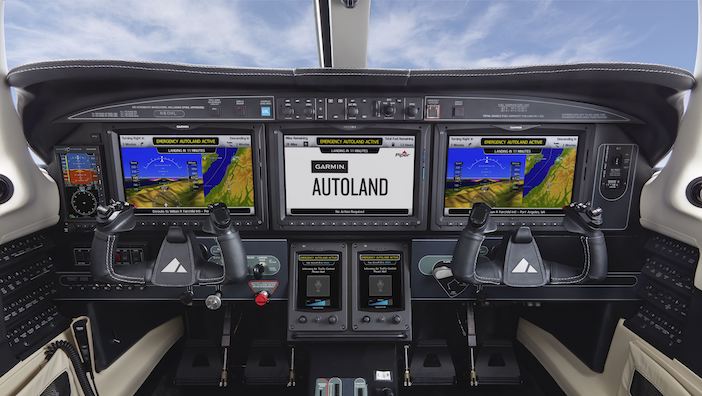Global Avionics Round-Up from Aircraft Value News (AVN)

Garmin G3000 with Autoland Technology. (Image: Garmin)
Garmin in October 2024 introduced the G3000 Prime, its third-generation flight deck and its most advanced to date, with touchscreen primary displays and other features.
Garmin’s G3000 avionics suite, integrated with the new Autoland feature, is pioneering fully autonomous emergency landing capabilities. The system, designed for the Daher TBM 940 and Piper M600/SLS, allows the aircraft to land autonomously in the event of pilot incapacitation, making it a true milestone in general aviation safety.
Autoland is revolutionary as it autonomously controls all aspects of the landing procedure, from descent to touchdown and engine shutdown, even while communicating with air traffic control. In an emergency, a passenger can simply activate Autoland, after which the system locates the nearest suitable airport and manages the landing process with no input required from the cockpit.
Autoland-equipped aircraft are seeing an increase in value and lease rates due to the unmatched safety and reliability offered by this system. Autoland not only provides peace of mind for operators but also makes these aircraft appealing to first-time buyers and leaseholders in business aviation, contributing to higher demand and residual values.
The introduction of Autoland marks a significant shift in how both manufacturers and lessors perceive value—by prioritizing pilot safety and ease of use, Garmin’s G3000 with Autoland is reshaping the standards of general aviation.
The Garmin G3000 with Autoland Technology has been integrated into a variety of aircraft, primarily enhancing high-end turboprops and light jets. Specific models equipped with this advanced avionics suite include the Cirrus Vision Jet, Piper M600, and the Daher TBM 940/960.
In regional aviation, Autoland has proven to be a pivotal safety enhancement and operational feature, increasing aircraft appeal to operators, leasing companies, and buyers alike, while positively affecting base values and lease rates.
Autoland enables autonomous landings in emergencies if the pilot is incapacitated, which significantly reduces risk. This unique safety measure attracts operators and lessors focused on reducing liability and enhancing brand reputation.
With Autoland, aircraft appeal to a broader range of buyers, including those who may be less experienced with complex avionics systems. This increased demand has led to higher base values and lease rates.
Aircraft with Autoland technology are often eligible for operations into more restrictive airfields where enhanced safety protocols are in place, allowing more route flexibility.
Regional operators benefit from the reduced need for specialized pilot training in Autoland-equipped aircraft, making it easier to bring new pilots into the cockpit, while also promoting safer operations in various weather conditions.
By improving the reliability of flight operations in regions prone to rapid weather changes or limited visibility, Autoland technology has led to lower insurance premiums, which is appealing for smaller regional carriers with leaner budgets.
Regional operators equipped with Autoland-capable aircraft have a market edge in areas where safety is a top consideration, setting them apart from competitors who may not offer similar technology.
In essence, Garmin G3000’s Autoland Technology is bolstering the financial and operational viability of regional aviation, offering both safer flights and attractive cost efficiencies.
This article also appears in the November 4 issue of our partner publication Aircraft Value News.
John Persinos is the editor-in-chief of Aircraft Value News. You can reach John at: [email protected]